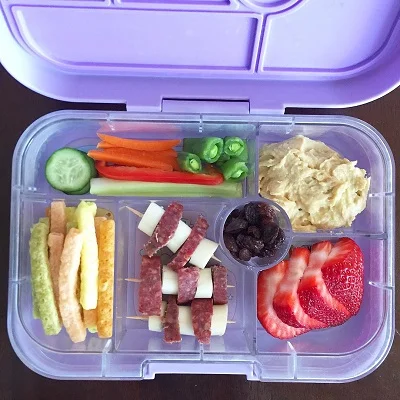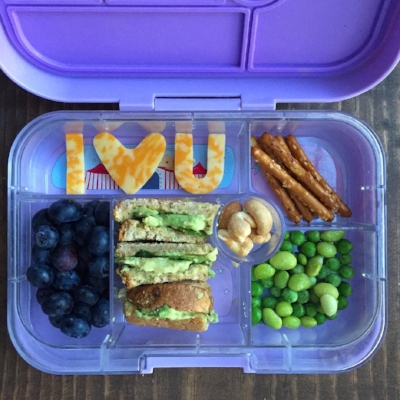How Much Protein Does My Preschooler Need?
One of the major requests I hear when it comes to "what to pack for lunch" stems from parents (and kids!) wanting ways to pack enough protein without always defaulting to a deli sandwiches or meat (which many kids consider too stringy).
What many parents don't realize though is how much protein their kids actually need each day. Would you believe it's not that much (by most adults standards)?
That's why this post will address not only the amount of protein children need, but also how easy it is to get the recommended amount through easy-to-include items that aren't sandwiches or straight meat. This post will also touch on another key nutrient parents need to pay just as much (if not more!) attention to when packing a nutritionally well-balanced lunchbox!
The timing of school's meals and snacks are becoming more and more concerning to parents. Especially in elementary school and thereafter, parents recognize that their kids may have large gaps between when breakfast is offered at home, lunch is given at school, and snacks after school can even be offered.
As we look at little kids appetites and intakes, the timing of meals and snacks becomes even more important. With smaller stomachs, young kids can't "fill up" the same way their older sibling or later teenage self might do. Instead, they rely on regularly spaced meals and snacks plus an age-appropriate offering of protein, fat, and carbohydrates to sustain their energy levels and meet their nutrient needs.
While fruits and veggies are vital to each kid's nutritional health and well being, the fiber from them alone won't keep kids as full as fat or protein will. So let's review what kids need from a nutritional standpoint with protein and fat and then address some bologna-free options for how to get in protein and fat at lunch time.
How much protein does my child need?
Most parents assume "a lot." The reality is though, it isn't as much as we assume. That's why I want to give you a bit more info on the nitty gritty math behind it so you can feel more comfortable calculating the average amounts that are adequate for your child.
Calculating Protein Needs (in grams)
The Recommended Daily Amount (RDA) for protein needs in kids is 1.1 g/kg/day for 1-3 year olds and 0.95 g/kg/day in 4-13 year olds. Since we don't use the metric system in the US, this equates to roughly 0.5 g/lb/day in 1-3 year olds and 0.43 g/lb/day in 4-13 year olds.
Multiply this amount of protein by your child's weight, and you get the average amount of protein they need to meet their protein needs. For a 26-pound two year old, this would be 13 grams of protein per day. For a 37-pound four year old, this would be 16 grams of protein per day.
If you divide that up between three meals and two snacks each day, that's about 3 g of protein per meal or snack (which is less than a single scrambled egg, cheese stick, or 8-oz glass of milk!).
Calculating Protein Needs (with an acceptable range)
Since no child, especially picky eaters, eats a predictable and consistent amount from day to day, another way to look at protein needs is by considering an acceptable range, known as Acceptable Macronutrient Distribution Range (or AMDR). This range of AMDR's for "macronutrients" (protein, fat, and carbs) helps give parents the peace of mind over how much of their child's diet should be made up of that macronutrient.
In the case of protein, children ages 1-3 years old have a AMDR of 5-20%. This means of all the calories your child eats in a day, 5-20% of them should be in the form of protein. So what does this equate to? For an average toddler (ages 1-3), they need an average of 1,200 calories a day. That means an appropriate range for their protein intake would be 15-60 grams of protein per day (based off of 4 calories/gram of protein)
How much fat does my child need?
One of the reasons I even share about the AMDRs above is to show the relative percentage of protein young children need compared to fat.
In working with several families, I know many parents are hyper focused on getting their child's protein needs met. However, very few parents realize that their children need over twice the amount of fat per day that they do protein.
Let's look at the calculations again, this time in terms of a child's fat AMDRs.
Calculating Fat Needs (with an acceptable range)
Children ages 1-3 years old have a AMDR for fat of 30-40%. This means that for an average toddler (ages 1-3) who needs an average of 1,200 calories a day, they need 40-53 grams of fat per day (based off of 9 calories/gram of fat).
What exactly does this look like?
Now that you have learned how to do the math for how much protein and fat your child needs each day, you are probably wondering how the grams of protein and fat translate to real life?
Great question. That's where we get to talking about "servings," and how many "servings per day" it usually takes for a child to meet their nutritional needs. For an average toddler eating 1,200 calories per day, the Dietary Guidelines for Americans advises the following number of servings for each food group:
Fruits: 1 cup
Veggies: 1.5 cups
Grains: 4 ounces
Protein: 3 ounces
Dairy: 2.5 cups
Since ounces and cups still aren't as straight-forward as seeing what an actual kid eats, there are some great resources available to show you what a serving of fruits, veggies, grains, meat, and dairy actually looks like this one:
What are some real life examples?
For some help putting this all into practice, here are 10 simple examples of ways to offer proteins and fat at lunch -- no sandwiches nor sweat required! A summary of these options are included at the bottom of this post.
Edamame packs 5 grams of protein per 1/4 cup!
Build Your Own Nachos with bean based chips + one cheese slice pack 8 grams of protein!
A 1.5-ounce skinless chicken leg + 1/4 cup of quinoa salad packs 12 grams of protein!
1/4 cup of beans + 2 tablespoons of green peas packs 5 grams of protein!
A fruit and nut bar packs 6 grams of protein!
1-ounce of smoked salmon packs 7 grams of protein!
1/2-ounce of uncured salami pieces + 1/2-ounce cheese stick + 1/4 cup of hummus packs 12 grams of protein!
1/4 of a high protein waffles pack 5 grams of protein!
1/2 cup of Greek yogurt packs 11 grams of protein!
One slice of smashed avocado and chickpea toast packs 6 grams of protein!
Summary
For any of you skimmers out there, here is what you need to remember from this post:
Kids ages 1-3 need 5-20% of their diets made up of protein. This equals an average of 0.5 grams protein per pound of body weight (so a 26 pound two year old needs 13 grams protein).
Kids ages 1-3 need 30-40% of their diets made up of fat. This equals an average of 40-50 grams fat per day.
Kids can get protein from a variety of foods including both plant- and animal-based options. Some kid-friendly lunchbox ideas include: edamame, cheese, chicken, quinoa, beans, green peas, fruit and nut bars, smoked salmon, uncured meats, hummus, breakfast for lunch, yogurt, and sandwiches.
Kids can get fat from a variety of foods including both plant- and animal-based options too. Whenever possible, focus on plant-based fats or those that are rich in omegas (like those found in salmon, walnuts, tuna, and hemp and chia seeds).
Mix up what types and amounts of proteins and fats you offer your children each day! This not only helps prevent food jags and picky eating, but also promotes variety to help your kids get the nutrition they need.













